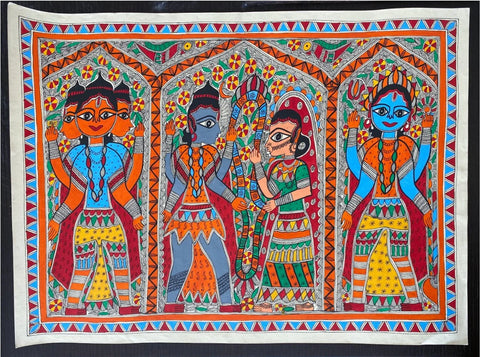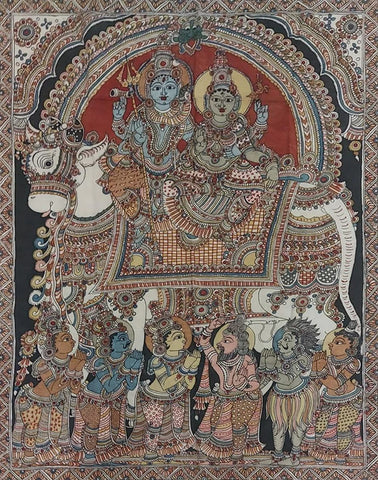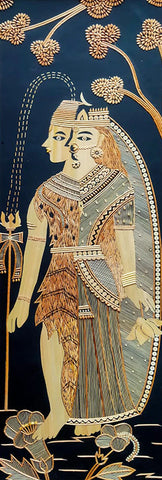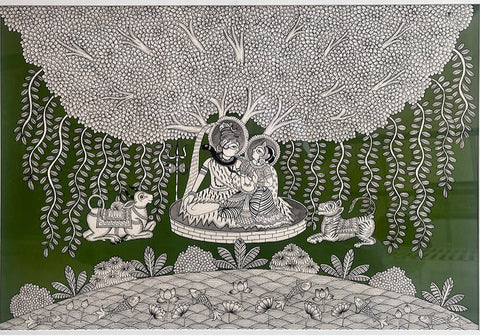The holy trinity consists of Shiva, Vishnu, and Brahma. When Shiva (Siva), the God of destruction, joins with Parvati, the daughter of the Himalayas, they form the most powerful duo in the entire universe. Parvati is his inseparable companion. In fact, it is believed that to truly honour Shiva, one must also venerate Parvati, who is Shakti, the embodiment of energy. Hence, the term Ardhanarishvara, meaning ‘lord whose half is a woman’. This idea is deeply understood by traditional indigenous artists and artisans who constantly remind us through many techniques and types. Let us see how it is depicted in each corner of the country:
Madhubani
Madhubani art is a stunning example of traditional Indian art, famous for its vibrant colours, motifs, and intricate geometric patterns. The walls of villages have long served as the canvases for the village women in Nepal and Mithila regions. Women artisans in Nepal and Mithila regions have used organic colours, twigs, matchsticks, and even their fingers to create beautiful designs on the walls of their villages for centuries. The motifs of Madhubani art often include fishes, peacocks, and trees of life, all symbolising peace, prosperity, and abundance. The origin of Madhubani paintings can be traced back to the Ramayana, where King Janak of Mithila commissioned painters to create Mithila artwork for his daughter's wedding. The painters brought age-old tales to life using domestic materials, depicting episodes from the Ramayana, Mahabharata, and Purana, and portraying the marriages of tribal women. Pratima Bharti, a State Award-winning artist, has done an incredible job of depicting the collective consciousness of Madhubani through her artworks. One of her notable works is a portrayal of Shiv Parvati's wedding, where the ash-smeared Shiva in his tiger skin and Parvati in her bridal garment exchange flowers while Vishnu and Brahma witness the auspicious moment. The entire episode is enclosed in one single painting, surrounded by a border with bold colours and geometric lines. Some of the defining characteristics of Madhubani are, there is no empty space in the painting, every inch covered with flora, fauna or geometric patterns. Here, the depiction of the deities is in a typical folk manner, with flat 2-dimensional rendering of figures. The iconography of the deities is in accordance with the Hindu pantheon, depicting the four-headed Brahma, and Vishnu with his Sudarshan chakra.
Kalamkari
The present-day states of Andhra Pradesh and Telangana are said to be the birthplace of the intricate, pattern-rich, Kalamakari art form. The ancient art gets its name from the use of bamboo Kalam or pen. One of the most remarkable aspects about this vivid art is its use of organic dyes. Natural elements, flora and fauna such as peacocks, and tigers alongside episodes of deities from sacred Indian texts are common themes. The creator of this magnificent painting, Sudheer has perfectly captured the majesty of the divine couple. Sudheer’s talent and dedication to his craft have led him to win numerous accolades, including the Andhra Pradesh State Award in 2007 and the Konaseema Chitrakala Parisad Award in 2009. In this painting, the benevolent Shiva is sitting close to his consort, Parvati, radiating their divine aura. Seated on a highly bejewelled Vahana- Nandi, they can be seen in Varada Mudra, blessing their creations. Shiva, in his state of calm, is holding his consort closely, while Parvati is smiling in her state of tranquillity. Below them are devas, asuras, rishis folding their hands in reverence and enraptured by the divine presence of Shiva and Parvati. The deities are set in a traditional temple-like architectural setting. The deities are depicted in a royal-manner, with resplendent jewellery and bejewelled crowns. One can differentiate between the asuras, devas, and brahmins based on their facial structure, rendering of the body and choice of clothing. Here time and scale seem to dissolve into an ethereal realm. The painting exudes a divine aura and is worth taking a look at!
Sikki Grass Work
Sikki, the golden grass found in the state of Bihar, holds immense potential that cannot be fully fathomed. The Sikki craft is principally found in Bihar, Uttar Pradesh, and the Terai region of Nepal. From boxes, containers, toys, jewellery boxes, and even in the creation of meticulous art, Sikki cannot be underestimated. The beauty of these products is also that they are light and sustainable. Suraj Kumar Sahu, with his extraordinary talent, has been infusing artistic elegance into Sikki crafts for a very long time. The way every strand of Sikki grass is manipulated to carve the union of Shiva-Parvati or Shakti is remarkable! This particular portrayal in itself holds immense symbolic significance. What we see here is the illustration of Ardhanarishvara. In this, Shiva draws the feminine aspect into himself. There is a belief that Brahma was unable to produce females for procreation, so he began a penance to please Shiva. After several millennia, Shiva appears in the form of Ardhanarishvara and detaches his left half “Shakti”. Shakti gives Brahma the boon of creating women through his mind. The Ardhanarishwar is both, Prakriti and Purush, the matter and the spirit, Nara, and Nari, etc. This duality is perceived by the Vedas in several existing things- Agni and Soma, Pita and Mata, Linga and Yoni, Heaven and Earth, and so on. Shiva holds a Trishula, symbolising his power to destroy ignorance and ego, while Parvati holds a lotus; she is the storehouse of energy, nourishment, and harmony. This Sikki representation has harmoniously captured Shiva and Shakti as a unified entity, exuding sublime beauty.
Phad
Local deities, folk stories, and episodes from Ramayana, Mahabharata, Hanuman Chalisa, and even Panchatantra have found a safe haven in the striking scroll paintings of Phad, a 700-year-old tradition originating in Rajasthan. Phad means ‘that which folds’. These portable Phad paintings were carried by the priest-singers called Bhopas and their female companions, Bhopis belonging to the Rabari tribes. They would sing and perform stories of their local deities like Devnarayanji (a reincarnation of Vishnu) and Pabuji (the local deity). Historically, this detailed, and labour-intensive art form was exclusively practised by the members of the Joshi family, who belong to the Chipa caste. One notable figure in the lineage of Phad art is Kalyan Joshi. His artistic journey began at the age of eight, under the guidance of his father and revered Guru, Shree Shrilal Joshi. The stories depicted through these paintings are complex and equally complex is the art of creating a perfect Phad canvas. The canvas is created using wheat/rice flour, Kheriya Gond (local gum), and Mohra (stone tool). Initially, the sketched yellow colours are painted using a light yellow organic colour, and the process is called ``Kachi likhai karna”. Kalyan Joshi’s Shiva and Parvati Phad painting is laden with intricate detailing. At the very centre of the painting is Shiva, accompanied by his companion, Parvati. While she sits by his side with complete devotion and pride in her eyes, Shiva, with his matted locks, crescent moon, donning a tiger skin, rudraksh malas, gazes directly into her eyes with utmost peace and reverence. Beside them sit their loyal vahanas, the celestial bull -Nandi, and the fierce tiger. The presence of fishes, lotuses, and other nature motifs enhance the tranquil aura of the scene, where the supreme forms of masculinity and femininity are in harmonious balance.
Kalighat
Similar to Phad, Bengal Patachitra is also a scroll art, done on a long piece of cloth. The stories presented in Pattachitra art are recounted with full expressions and emotions by the skilled Patuas. The art is not just restricted to the state of Bengal, it is also practised in the states of Odisha and Bihar. Interestingly, Pattachitra does not restrict itself to long-form paintings. With time, it has adapted and given birth to other forms. Depicting modern themes and keeping abreast of time, Kalighat is one of them.
Since Kalighat has long been a renowned religious location among temple-goers and travellers, the artists started creating cloth-based paintings with distinctive themes to earn their living, and this led to the tradition of Kalighat paintings. The elaborate art
of Kalighat is demonstrated by the use of organic dyes by the Chitrakars or painters- burnt carbon for black, aprajita flower for blue, turmeric for yellow, and rice powder for white are some of the sources for these paintings. Some of the most depicted themes are episodes from the epics, Hindu deities such as Shiv, Kali, Krishna, and Durga, local folklore, and Sufi traditions. Uttam ji is one of the gifted artists in the traditions of the Kalighat paintings, whose journey as a painter began at a young age under the tutelage of his father.
The mutual understanding and timeless companionship come to life in Uttamji’s Kalighat painting of Shiv and Parvati. Shiva, typically represented in his blue skin, is seated alongside his elegantly-attired companion Parvati. The simplistic depiction of the deities make it seem as if they are simple-village dwellers. There is no stylised or exaggerated depiction, apart from their third eye. The background is simple, bringing our entire focus on the deities. They are seated calmly on the devoted bull Nandi. The seamless and smooth brushstrokes, bold colours, and distinct patterns come together and impart a unique characteristic to the depiction.
COMPARE AND CONTRAST
It is fascinating how the same theme can be depicted in so many different ways. In each art form of India, there is a unique method of depicting the deities. The scroll paintings, such as Phad and Bengal Pattachitra, focus on the overall impact of the stories, with a heavy emphasis on their surroundings. Whereas the sectional paintings depict the deities in contrast to their surroundings. There is more focus on the expressions and ornamentation of the deities rather than their surroundings, which may be simple or intricate. Not only the deities but even the designs made to fill in the painting are different from each other, based on the method of the art form followed. For example, the Kalamkari paintings are full of traditional Kalamkari motifs with stylized flowers, jewellery, and patterns all across the painting. Whereas the Kalighat paintings have an almost life-like depiction of the deities, with elements one would expect to find in the region. It is safe to say that irrespective of the similarity of themes, the depiction is unique concerning its style, design, and motifs.
- “Kalamkari: A Traditional Indian Art Form.” Laasya Art, December 12, 2022. https://laasyaart.com/kalamkari-a-traditional-indian-art-of-perfection/.
- “Madhubani (Mithila) Painting - History, Designs & Artists.” Madhubani (Mithila) Painting - History, Designs & Artists. Accessed February 28, 2024. https://www.culturalindia.net/indian-art/paintings/madhubani.html.
- “Phad Paintings of Rajasthan – a Tale of Tradition, Storytelling and Revival in the Modern Day.” Artisera. Accessed February 28, 2024. https://www.artisera.com/blogs/expressions/phad-paintings-of-rajasthan.
- “What Is the Legendary Phad Painting of Rajasthan?” Rajasthan Studio, May 3, 2022. https://rajasthanstudio.com/what-is-the-legendary-phad-painting-of-rajasthan/.
- “Sikki/ Golden Grass Craft of Bihar.” Asia InCH – Encyclopedia of Intangible Cultural Heritage. Accessed February 28, 2024. https://www.asiainch.org/craft/sikkigolden-grass-craft/.
- “Sikki.” Story of Indian crafts and craftsmen, October 12, 2013. https://gaatha.com/sikki-grass-craft-bihar/.
- “Bengal Pattachitra.” Sarmaya, August 4, 2020. https://sarmaya.in/guides/bengal-pattachitra/.
- Sahu, Smriti, and Asma Khan. “Unfurling a World of Wonder: A Journey into Bengal Pattachitra.” Memeraki Retail and Tech Pvt Ltd., February 5, 2024. https://www.memeraki.com/blogs/news/unfurling-a-world-of-wonder-a-journey-into-bengal-pattachitra.
- “Ardhanarishvara in Art and Philosophy.” Indian Artwork - Buddha Statues & Hindu Books - Exotic India Art, June 15, 2005. https://www.exoticindiaart.com/article/ardhanarishvara/.
- “The Complete Love Story of Shiva and His Shakti Parvati.” Raktim Dutta, July 26, 2021. https://raktimdutta.com/shiva-parvati-love-story/.




























